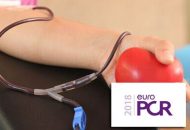Since the publication of the original SYNTAX trial, there have been great technical advancements that have influenced the results of angioplasty: New tools for risk stratification using the SYNTAX II score which integrate clinical and anatomical variables to the team’s decision-making process. Functional revascularization (hybrid use of fractional flow reserve or instantaneous wave-free ratio). Optimization of…
EuroPCR 2018 | DESSOLV III: Bioabsorbable vs. Durable Polymer at 2 Years
Most drug-eluting stents are coated by a polymer that is used to contain the antiproliferative drug. Once the drug is released, the polymer remains in place and its presence has been associated with inflammation, restenosis, and neoatherosclerosis. The MiStent device features a polymer that becomes bioabsorbable once the drug has been released, which could, theoretically,…
EuroPCR 2018 | LEADERS FREE: Complex Angioplasty in Patients with High Risk for Bleeding
The LEADERS FREE study showed that a biolimus A9-coated polymer-free stent was superior to a conventional stent in terms of safety and efficacy in patients who received dual antiplatelet therapy for only a month due to their high risk for bleeding. In this substudy, researchers analyzed 667 patients enrolled in the original LEADERS FREE trial who met certain requirements…
EuroPCR 2018 | LeDRA: Left Distal Radial Approach for angiography and angioplasty
The left distal radial artery has been recently proposed as an alternative in selected patients with high success rate and low complications rate. This study evaluated the feasibility and safety of this puncture both for coronary angiography and angioplasty. It included 200 consecutive patients with palpable left distal radial artery punctured by three expert operators.…
EuroPCR 2018 | BIO-RESORT: Polymer vs. Bioresorbable Polymer; Have We Reached a Plateau with DES?
This study randomized 3514 patients to a thin-strut biodegradable polymer everolimus-eluting stent (SYNERGY) vs. a sirolimus-eluting stent (ORSIRO) vs. a durable polymer zotarolimus-eluting stent (RESOLUTE INTEGRITY). The combined endpoint, the rate of target vessel failure, was similar for all three devices (8.3% for the zotarolimos-eluting stent, 6.8% for the everolimus-eluting stent, and 6.6% for the sirolimus-eluting…
EuroPCR 2018 | FFR Reduces Death and Infarction Rates Compared with Medical Treatment
Pooled data from the most important recently published studies (FAME 2, Compare-Acute, and DANAMI3-PRIMULTI) conclude that there is a significant difference in favor of fractional flow reserve (FFR) as regards hard endpoints. Coronary revascularization guided by FFR reduces the risk of death and infarction when compared with optimal medical treatment in patients with stable and…
EuroPCR 2018 | FAME 2: FFR Shows 5-Year Benefit for Hard Endpoints
After a 5-year follow-up, and for the first time, functional assessment with fractional flow reserve (FFR) showed clear benefit for a hard endpoint: acute myocardial infarction. Use of FFR in patients with stable coronary artery disease so as to identify hemodynamically significant lesions in order to restrict angioplasty treatment to them has long-term benefits compared…
EuroPCR 2018 | ORBITA: The Link Between Ischemia and Symptoms Is Still Not Entirely Understood
Invasive physiology tests used in the ORBITA trial could not predict which patients would benefit from angioplasty more than placebo (sham procedure) in terms of the trial’s primary endpoint, improvement in exercise time. These data were presented at EuroPCR 2018 and published simultaneously in Circulation. Results encourage debate over the importance of ischemia reduction with angioplasty…
EuroPCR 2018 | SYNTAX III REVOLUTION: Excellent Correlation Between Angiography and Computerized Tomography in Patients with Left Main and Multivessel Disease
In patients with left main or three-vessel coronary disease, heart team decisions on revascularization strategy (angioplasty or surgery) may be made based solely on noninvasive computerized tomography (CT) angiography, since there is great correlation between its results and those determined by conventional angiography. For the SYNTAX III REVOLUTION study, Dr. Serruys and his colleagues randomized…
EuroPCR 2018 | SCAAR Registry at 10 years: FFR improves decision making in the long term
The SCAAR registry aimed at showing the differences in mortality at very long term when using functional assessment of coronary lesions (with FFR or iFR) in patients with chronic stable angina. The study compared 3460 patients assessed with FFR/iFR against 21221 patients undergoing PCI based on angiography, between January 2005 and March 2015. As…
Maintaining Physical Activity After an Acute Myocardial Infarction Reduces Mortality
Performing a successful primary angioplasty and prescribing preventive medication without advising on the importance of keeping up with or taking up physical activity is a waste of one of our many opportunities to improve the quality of life of our patients and reduce mortality among them. If clinical cardiologists do not take over the patient,…










